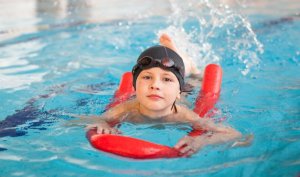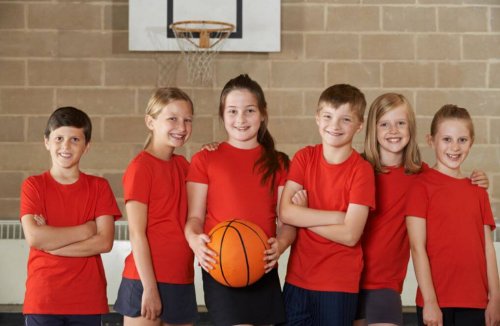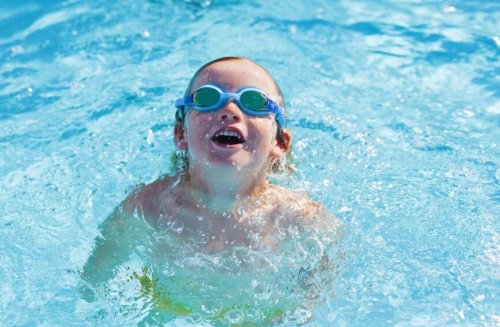Attention Deficit Hyperactivity Disorder and Athletic Ability

Attention Deficit Hyperactivity Disorder is a mental disorder that occurs in both children and adults. It’s characterized by three principal symptoms: hyperactivity, impulsivity, and lack of attention.
Treatment for people suffering from this disorder involves medical, psychological, and educative intervention, as well as behavioral management.
You might also like: Psychological Factors that Improve Sports Performance
However, children suffering from Attention Deficit Hyperactivity Disorder can still enjoy athletics. In fact, participating in athletic activities could help improve their social skills, demonstrate their strengths and increase their self-esteem.
Additionally, research indicates that exercise benefits attention span and focus. Athletics affects the dorsolateral prefrontal cortex and releases exercise-induced dopamine.
Attention Deficit Hyperactivity Disorder and sports
One of the best ways to help children with Attention Deficit Hyperactivity Disorder is by encouraging them to participate in the activities they enjoy the most. Even better if these are also motivational activities, such as sports.
In fact, sports play a key part in many children’s lives. There’s no reason why children with this disorder shouldn’t practice sports.

There is little research regarding the connection between which sports work best for children. However, some studies have shown that Tai chi helps adolescents reduce anxiety. It can also help improve behavior and produce fewer inappropriate emotions and episodes of hyperactivity.
Also, sports offer social interaction as well as a good physique. Therefore, children with Attention Deficit Hyperactivity Disorder will be able to connect with their peers.
Keep in mind that sometimes children with this disorder feel isolated and have difficulties relating to their peers. For that reason, sports can be a healthy way to make friends. As a result, sports have the ability to help young people gain confidence and self-esteem.
How to choose the perfect sport
It’s not always easy to find the perfect sport, regardless of whether your child has ADHD or not. Therefore, it’s recommended that children with this disorder try as many different athletic activities as possible. They can be performed at school or outside.
The idea is that they have the opportunity to decide which sport generates the most interest and motivation from them.
As a general rule, children with Attention Deficit Hyperactivity Disorder tend to do better at sports when they receive a lot of individual attention from coaches. For that reason, it’s more likely that they will be successful at individual sports such as swimming, boxing, wrestling, martial arts, and tennis.
However, team sports such as soccer, water polo, and basketball could be suitable. That being said, don’t overlook the fact that the majority of these sports require that children pay constant attention. This includes attention not only to other players but also to game strategy.
Unfortunately, this won’t be very straightforward for children with this disorder. However, don’t hesitate to motivate your child to try sports that they desire. Additionally, we recommend that if your child is not very competitive, it’s better not to choose an activity where children compete with each other.
Our suggestion: swimming
Swimming is the ideal sport for defining the importance of exercise to children suffering from Attention Deficit Hyperactivity Disorder. Among other things, the main objective of working out in the water is, on one hand, to let the child have fun.
On the other hand, these goals are also clear: challenge their abilities, strengthen the immune system, increase strength, and improve self-esteem. Consequently, the child will be more prepared to confront challenges in the future.
You might also like: Warm-Ups and Stretches for Swimming: Effects and Benefits

Among other things, water has the surprising ability to relax. It can also create a feeling of refresh and restart in just a short period of time. This contributes to the child placing all their attention onto what’s happening in the pool.
As a matter of fact, you can begin testing the limits of your child’s attention span and their coordination abilities. For example, you can ask them to sit on the edge of the pool and make circles with their arms in the water.
The idea is to test their abilities and keep changing the exercises continuously. This way, you are increasing their attention span so that the child can complete more exercises over a longer period of time. This goes along with the objectives you defined beforehand.
On the other hand, the lungs also play a key role in concentration. Keep in mind that while swimming, hydrostatic pressure is exerted onto the lungs. This promotes improved lung function out of the water too. This causes the lungs to work harder when doing aerobic exercise such as running or riding a bicycle.
The more oxygen that enters the brain, the better your child will be able to concentrate and for a longer period of time.
Gaining confidence through sports
Lastly, don’t forget that just like all children, those with Attention Deficit Hyperactivity Disorder must release energy. Water can regulate energy levels and channel this towards success in all areas of life. Water can also assist in perfecting movement abilities.
Additionally, remember that having fun, participating and making meaningful connections with peers is far more important than the competitive aspect of sports. In short, the real impact of participating in sports will show in your child’s self-esteem, confidence, and social life.
Attention Deficit Hyperactivity Disorder is a mental disorder that occurs in both children and adults. It’s characterized by three principal symptoms: hyperactivity, impulsivity, and lack of attention.
Treatment for people suffering from this disorder involves medical, psychological, and educative intervention, as well as behavioral management.
You might also like: Psychological Factors that Improve Sports Performance
However, children suffering from Attention Deficit Hyperactivity Disorder can still enjoy athletics. In fact, participating in athletic activities could help improve their social skills, demonstrate their strengths and increase their self-esteem.
Additionally, research indicates that exercise benefits attention span and focus. Athletics affects the dorsolateral prefrontal cortex and releases exercise-induced dopamine.
Attention Deficit Hyperactivity Disorder and sports
One of the best ways to help children with Attention Deficit Hyperactivity Disorder is by encouraging them to participate in the activities they enjoy the most. Even better if these are also motivational activities, such as sports.
In fact, sports play a key part in many children’s lives. There’s no reason why children with this disorder shouldn’t practice sports.

There is little research regarding the connection between which sports work best for children. However, some studies have shown that Tai chi helps adolescents reduce anxiety. It can also help improve behavior and produce fewer inappropriate emotions and episodes of hyperactivity.
Also, sports offer social interaction as well as a good physique. Therefore, children with Attention Deficit Hyperactivity Disorder will be able to connect with their peers.
Keep in mind that sometimes children with this disorder feel isolated and have difficulties relating to their peers. For that reason, sports can be a healthy way to make friends. As a result, sports have the ability to help young people gain confidence and self-esteem.
How to choose the perfect sport
It’s not always easy to find the perfect sport, regardless of whether your child has ADHD or not. Therefore, it’s recommended that children with this disorder try as many different athletic activities as possible. They can be performed at school or outside.
The idea is that they have the opportunity to decide which sport generates the most interest and motivation from them.
As a general rule, children with Attention Deficit Hyperactivity Disorder tend to do better at sports when they receive a lot of individual attention from coaches. For that reason, it’s more likely that they will be successful at individual sports such as swimming, boxing, wrestling, martial arts, and tennis.
However, team sports such as soccer, water polo, and basketball could be suitable. That being said, don’t overlook the fact that the majority of these sports require that children pay constant attention. This includes attention not only to other players but also to game strategy.
Unfortunately, this won’t be very straightforward for children with this disorder. However, don’t hesitate to motivate your child to try sports that they desire. Additionally, we recommend that if your child is not very competitive, it’s better not to choose an activity where children compete with each other.
Our suggestion: swimming
Swimming is the ideal sport for defining the importance of exercise to children suffering from Attention Deficit Hyperactivity Disorder. Among other things, the main objective of working out in the water is, on one hand, to let the child have fun.
On the other hand, these goals are also clear: challenge their abilities, strengthen the immune system, increase strength, and improve self-esteem. Consequently, the child will be more prepared to confront challenges in the future.
You might also like: Warm-Ups and Stretches for Swimming: Effects and Benefits

Among other things, water has the surprising ability to relax. It can also create a feeling of refresh and restart in just a short period of time. This contributes to the child placing all their attention onto what’s happening in the pool.
As a matter of fact, you can begin testing the limits of your child’s attention span and their coordination abilities. For example, you can ask them to sit on the edge of the pool and make circles with their arms in the water.
The idea is to test their abilities and keep changing the exercises continuously. This way, you are increasing their attention span so that the child can complete more exercises over a longer period of time. This goes along with the objectives you defined beforehand.
On the other hand, the lungs also play a key role in concentration. Keep in mind that while swimming, hydrostatic pressure is exerted onto the lungs. This promotes improved lung function out of the water too. This causes the lungs to work harder when doing aerobic exercise such as running or riding a bicycle.
The more oxygen that enters the brain, the better your child will be able to concentrate and for a longer period of time.
Gaining confidence through sports
Lastly, don’t forget that just like all children, those with Attention Deficit Hyperactivity Disorder must release energy. Water can regulate energy levels and channel this towards success in all areas of life. Water can also assist in perfecting movement abilities.
Additionally, remember that having fun, participating and making meaningful connections with peers is far more important than the competitive aspect of sports. In short, the real impact of participating in sports will show in your child’s self-esteem, confidence, and social life.
All cited sources were thoroughly reviewed by our team to ensure their quality, reliability, currency, and validity. The bibliography of this article was considered reliable and of academic or scientific accuracy.
- Barbosa S, Urrea A. (2018). Influencia del deporte y la actividad física en el
estado de salud físico y mental: una revisión bibliográfica . Katharsis (25). Disponible en: https://dialnet.unirioja.es/servlet/articulo?codigo=6369972 - Chang K, Suyen L, Hiu-Hsiang Y, et al. (2012). Effect of Acute Exercise on Executive Function in Children with Attention Deficit Hyperactivity Disorder. Archives of Clinical Neuropsychology, 27(2), pp. 225–237. Disponible en: https://academic.oup.com/acn/article/27/2/225/4181?login=false
- Carrillo J, Gómez M, Baena A, et al. (2013). El Tai-Chi en las clases de Educación Física de Educación Secundaria Obligatoria: una propuesta para promocionar la salud. Revista Educación y futuro digital (6). Disponible en: https://redined.educacion.gob.es/xmlui/bitstream/handle/11162/119009/EYFD_65.pdf?sequence=1&isAllowed=y
This text is provided for informational purposes only and does not replace consultation with a professional. If in doubt, consult your specialist.








